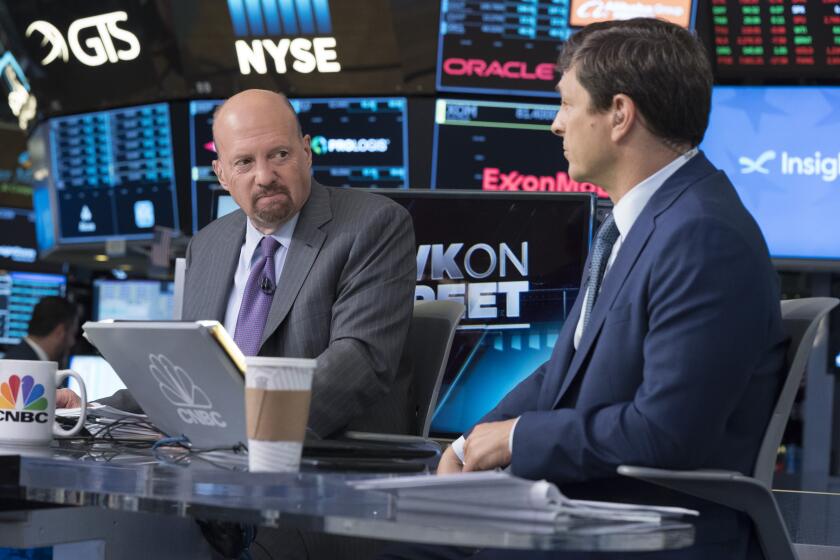Wall Street falls on new bank fears, bond yields plunge

- Share via
Markets shuddered Wednesday on worries about a spreading banking crisis and how badly it will hit the economy, and stocks and bond yields fell on both sides of the Atlantic.
The Standard & Poor’s 500 index sank as much as 2.1% before ending the day with a loss of 0.7%, while markets in Europe fell more sharply as shares of Switzerland’s Credit Suisse dropped to a record low. The Dow Jones industrial average closed down 0.9% after dropping as much as 725 points. The Nasdaq composite rose 0.1% after erasing a steep decline.
Markets trimmed their losses toward the end of the day as the Swiss National Bank said it could provide some assistance to Credit Suisse “if needed.”
But that came only after a steep drop for Credit Suisse rattled investors worldwide. Its shares in Switzerland sank 24.2% after reports that its top shareholder won’t pump more money into its investment. The bank has been fighting troubles for years, including losses it took related to the 2021 collapse of investment firm Archegos Capital Management.
“They’ve had issues,” said Anthony Saglimbene, chief market strategist at Ameriprise. “It’s just coming at a time when there’s more uncertainty and there’s less confidence in the banking system.”
Consumer prices are rising faster than the Fed wants, but some economists still expect the central bank to suspend its year-long streak of rate hikes.
Wall Street’s harsh spotlight has intensified across the banking industry recently on worries about what may crack next after the second- and third-largest bank failures in U.S. history over the last week. Stocks of U.S. banks tumbled again Wednesday after enjoying a brief, one-day respite Tuesday.
The heaviest losses were focused on smaller and midsize banks, which are seen as more at risk of having customers try to pull their money out en masse. Larger banks also fell, but not by quite as much.
First Republic Bank sank 21.4%, a day after soaring 27%. JPMorgan Chase slid 4.7%.
Many analysts are quick to say the current weakness for banks looks nowhere near as bad as the 2008 crisis that torpedoed the global economy. But worries are nevertheless rising that pain spreading through the banking system could spark a downturn.
Silicon Valley Bank telegraphed that its securities holdings were underwater. Why didn’t the regulators act sooner?
“When you have worries about contagion and a financial crisis, there is increasing risk of a global recession,” Saglimbene said, pointing to the first drop in the price of U.S. crude oil below $70 a barrel since late 2021. A weaker economy would burn less fuel.
“The regional banks are so important to small businesses, midsized businesses” by providing loans, he said. “They’re a centerpiece of the economy.”
Much of the damage for banks is seen as a result of the Federal Reserve’s fastest barrage of interest rate increases in decades. The Fed has pulled its key overnight rate to a range of 4.50% to 4.75%, up from virtually zero at the start of last year, in hopes of driving down painfully high inflation.
Higher rates can tame inflation by slowing the economy, but they raise the risk of a recession later on. They also hurt prices for stocks, bonds and other investments. That latter factor was one of the issues hurting Silicon Valley Bank, which collapsed Friday, because high rates forced down the value of its bond investments.
The Fed’s fusillade of rate hikes over the year has shocked the system after years of historically easy conditions. In his annual letter to investors, BlackRock Chief Executive Larry Fink pointed to prior eras of rising rates that led to “spectacular financial flameouts,” such as the years-long savings and loan crisis.
“We don’t know yet whether the consequences of easy money and regulatory changes will cascade throughout the U.S. regional banking sector (akin to the S&L crisis) with more seizures and shutdowns coming,” he wrote.
Some of this week’s wildest action has been in the bond market, where traders are rushing to guess what all the chaos will mean for future Fed action. On one hand, stress in the financial system could push the Fed to hold off on raising rates again at its meeting next week or at least refrain from the larger rate hike it had been signaling.
On the other hand, inflation is still high. While taking it easier on interest rates could give more breathing space to banks and the economy, the fear is such a move by the Fed could also give inflation more oxygen.
Weaker-than-expected economic reports released Wednesday may have allayed some of those worries. One showed that inflation at the wholesale level slowed by much more last month than economists expected. It’s still high at 4.6% versus a year earlier, but that was better than the 5.4% that was forecast.
Other data showed that U.S. spending at retailers fell by more than expected last month. Such data could raise worries about a recession on the horizon, but they may also take some pressure off inflation in the near term.
That caused the yield on the two-year Treasury to plummet. It tends to track expectations for the Fed, and it dropped to 3.89% from 4.25% late Tuesday. That’s a massive move for the bond market. The two-year yield was above 5% just a week ago, its highest level since 2007.
In Europe, indexes tumbled on weakness from banks. France’s CAC 40 dropped 3.6%, and Germany’s DAX lost 3.3%. The FTSE 100 in London fell 3.8%.
On Wall Street, companies in the oil and gas business had the sharpest drops. Helping to cushion the blow were gains for several Big Tech stocks. They’ve had their own struggles recently, but they tend to benefit from lower interest rates.
All told, the S&P 500 fell 27.36 points to 3,891.93. The Dow lost 280.83 points to close at 31,874.57. The Nasdaq rose 5.90 points to 11,434.05.
AP business writers Joe McDonald and Matt Ott contributed to this report.
Silicon Valley Bank failed late last week, prompting fears of wider upheaval. Here’s what you should know about the collapse and what comes next.
More to Read
Inside the business of entertainment
The Wide Shot brings you news, analysis and insights on everything from streaming wars to production — and what it all means for the future.
You may occasionally receive promotional content from the Los Angeles Times.













